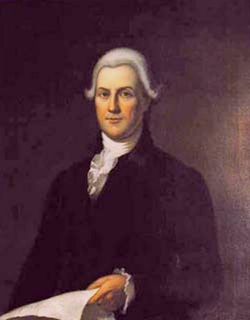The next Akley brother, after
Francis,
Joseph, and
Thomas, was John, baptized in September 1757.
In October 1764 John had just turned seven, and the Boston Overseers of the Poor sent him all the way out to
Springfield.
Samuel and Lucy Williams promised to teach the
boy to “Read Write & Cypher” and give him £13.6s.8d. when he came of age in 1779.
Before that date, war broke out. In April 1775, at the age of seventeen, John Akley marched with the town
militia company. That unit got as far as
Brookfield before the officers realized the emergency had passed and marched everyone home again. John served only three days that year.
In early 1776, however, John Akley enlisted in the
Continental Army. In his pension application filed in May 1818 from Norwich,
New York, he recalled that he had then lived in
Longmeadow, a part of Springfield that didn’t formally become a town until 1783. Akley reported that he was a
drummer and his first company commander was Capt. Silvanus Walker of Brookfield.
With that unit “he was in the battle at
Trenton at the taking of the
Hesians.” When his year was up, Akley recalled, he was discharged in Newtown, Pennsylvania. He then reenlisted for three years in the company of Capt. Asa Coburn of Sturbridge, regiment of Col.
Icahbod Alden of
Duxbury. Based on his experience, he was immediately made the drum major. He was nineteen.
During his second stretch, Akley stated, “he was in the Battle at the taking of
Burgoin [
Saratoga], and at Cherry Vally in the State of New York where the Col. was killed.” On 11 Nov 1778 Crown forces under
Joseph Brant and Maj.
Walter Butler attacked that settlement, catching Col. Alden and many other officers outside the fort. That defeat with civilian casualties became known to Americans as “the
Cherry Valley Massacre.”
On 1 Feb 1780, John Akley was discharged from the regiment, now led by Col.
John Brooks, at West Point. He went home and became close to Miriam Ward of West Springfield, then about sixteen years old.
In 1839 Miriam Akeley applied for a pension as John Akley’s widow. The
law providing such pensions offered more money to
women who had married soldiers while they were still in service. That might have influenced how Miriam Akeley described their nuptials on 29 Oct 1781:
John Akeley (or Ackley as the name is some times spelt) was at home on furlo and could not remain at home a sufficient time to be published according to the laws of Massachusetts, and that they went from West Springfield to Suffield in Connecticut and was there married (without being published) on the day where written by Rev. Mr. [Ebenezer] Gay Minister of said Suffield.
Suffield’s town clerk verified that marriage date. According to his widow, John Akley returned to the army in late 1781, then came home for good a year later.
Nonetheless, John Akley mentioned no such additional year in the army in his 1818 pension application.
Massachusetts Soldiers and Sailors of the Revolutionary War records his last army service in February 1780.
Massachusetts also listed a man named John Ackley serving on board the
Continental frigate Hague under Capt.
John Manley in 1783. However, that’s probably another man of the same name. John Akley’s 1818 application didn’t mention fighting at sea, either.
Another wrinkle appears in Charles Martyn’s
The William Ward Genealogy (1925). It states:
Miriam Ward married John Ackley of Brattleboro, Vt. They resided for a time in Brattleboro, then he disappeared and was never heard of again. She afterwards lived in Wethersfield, Conn.
That book lists two children for the couple, including Polly Ackley, who married a man named Flint in Wethersfield, Connecticut. Polly and John Flint appear in the Akleys’ pension file, so clearly it’s the same family.
According to the 1790 U.S. Census, “John Akeley” was then living in Guilford, Vermont, with one white boy and two white females—no doubt his son, wife, and daughter. That was close to Brattleboro. By 1800 that family may have moved to Hartford County, Connecticut, where a John Ackley and relatives appear on the census.
According to John Flint’s 1838 affidavit, he had known John Akley personally, Miriam Akley had lived at the Flint house in Wethersfield since about 1808, and John Akley was absent from that house “about eighteen or twenty years since.” Around that time, Polly Flint destroyed her father’s drum major warrant, “not supposing it to be of any value.”
Putting the dots together, that suggests John Akley left his extended family in Connecticut and went to central New York before 1818. He applied for a federal pension in Norwich that year. The government paid Akley that pension until he died on 1 Apr 1819.
Eventually word of John Akley’s death got back to his family in Connecticut, though Flint never knew the exact date, thinking it was in June 1820. Almost two decades later, the U.S. government approved a widow’s pension for Miriam Akeley. She was still signing for those payments (albeit with a mark) in 1848 at the age of eighty-five. Miriam Akeley finally died on 8 May 1850, and
her gravestone, mentioning her long departed husband by name, appears above.
TOMORROW: An Akley artillerist.


